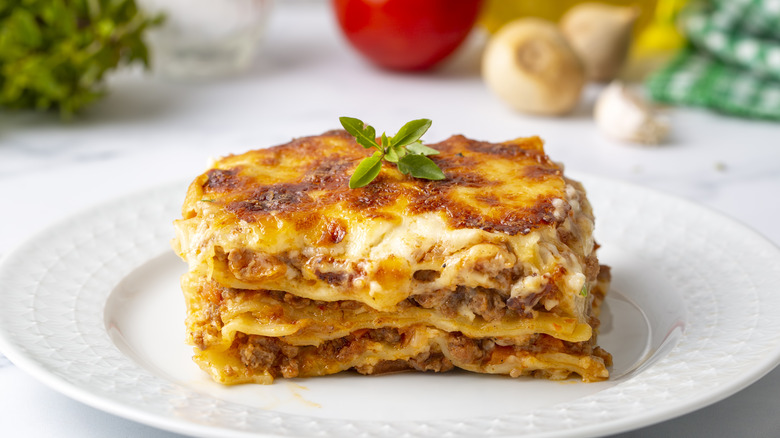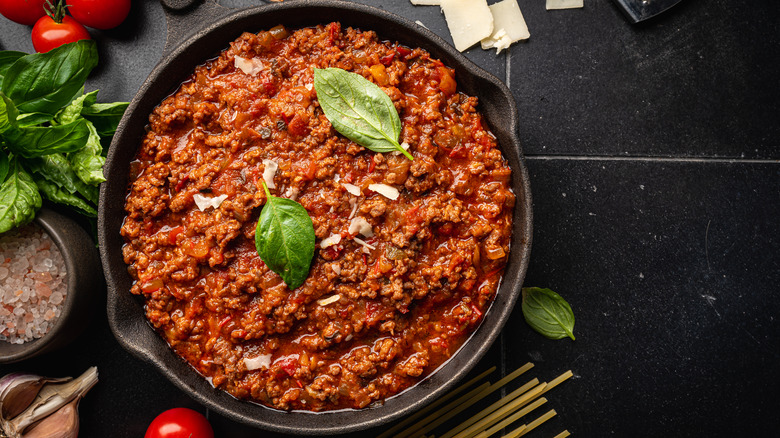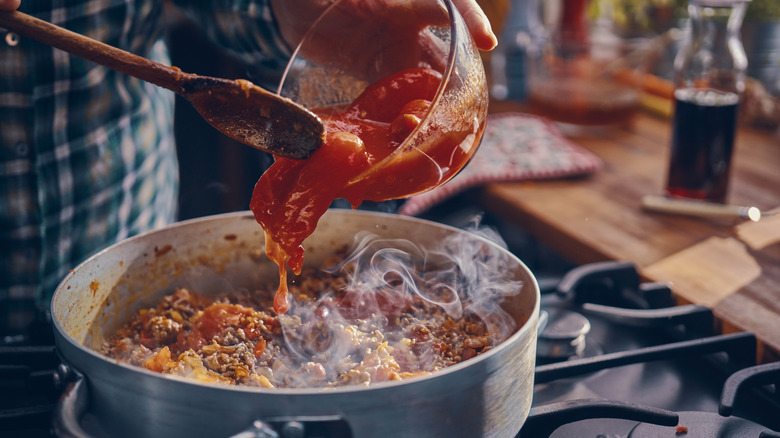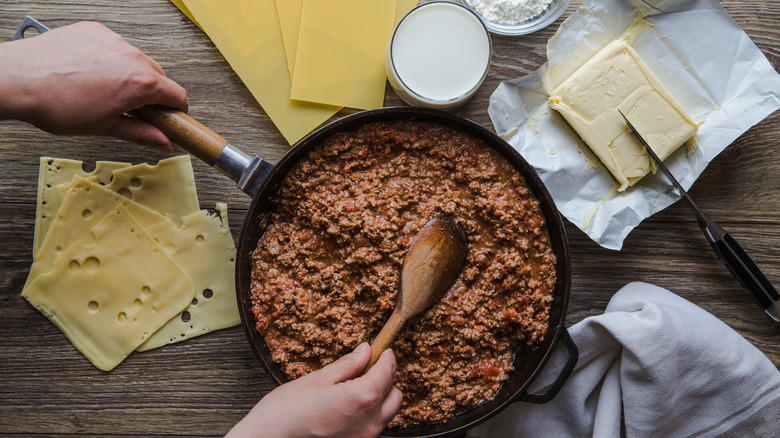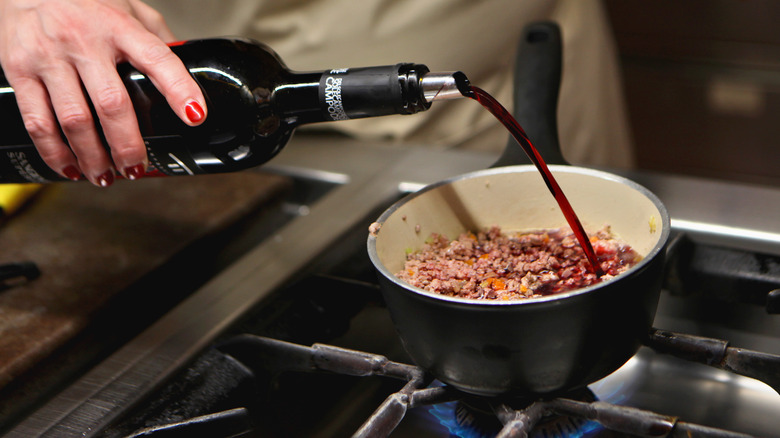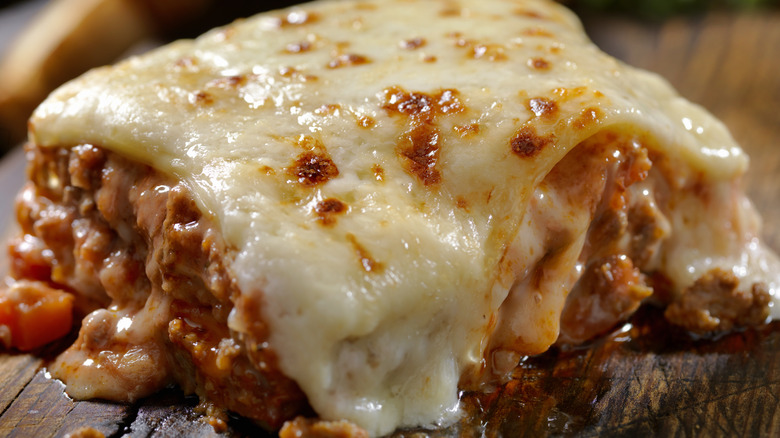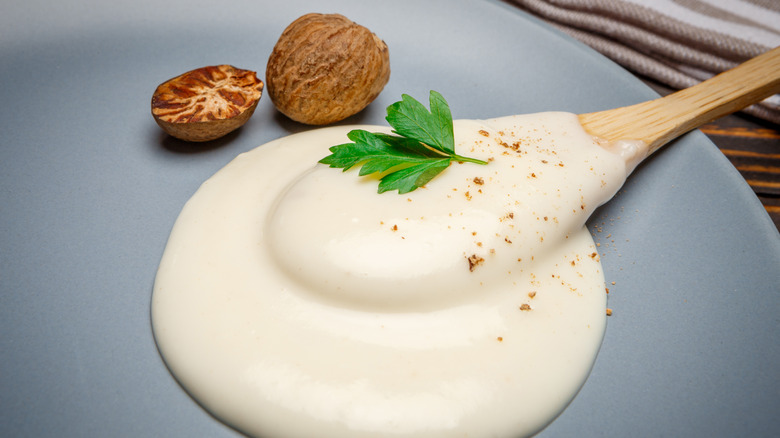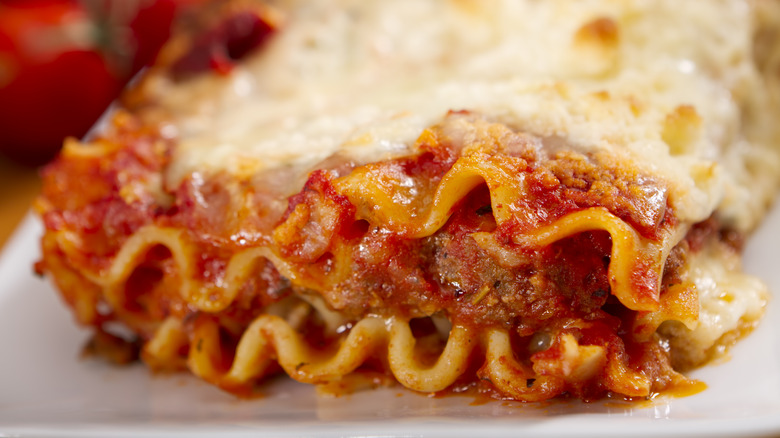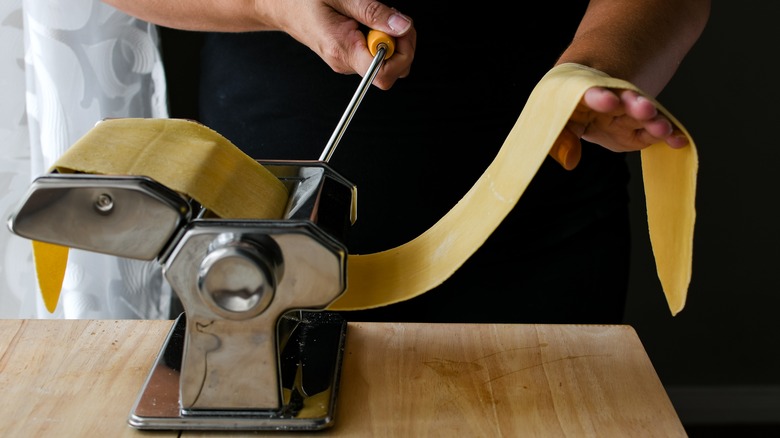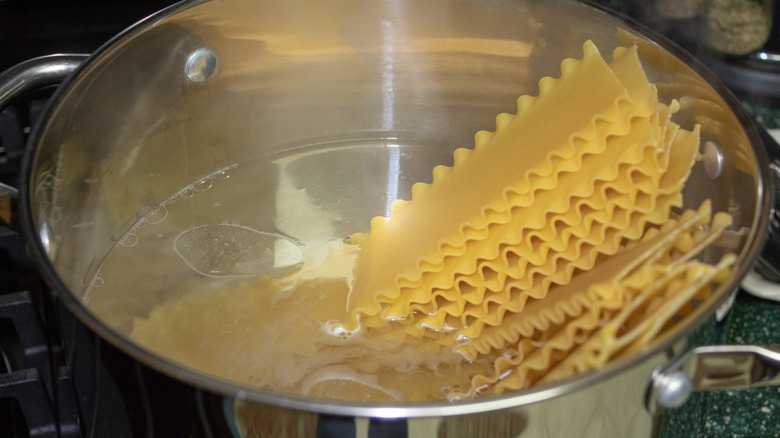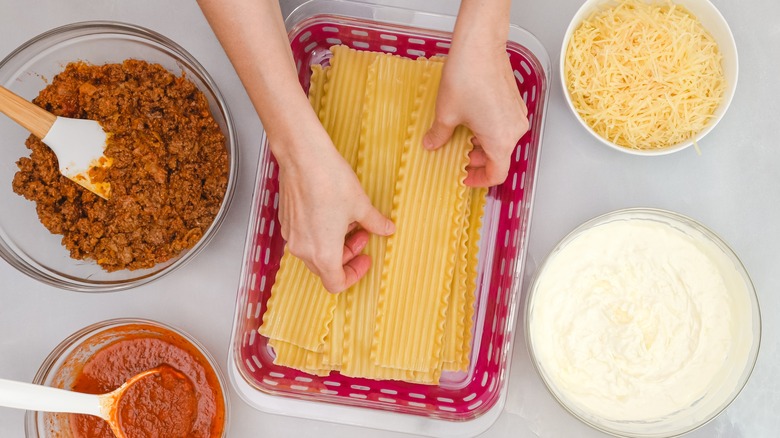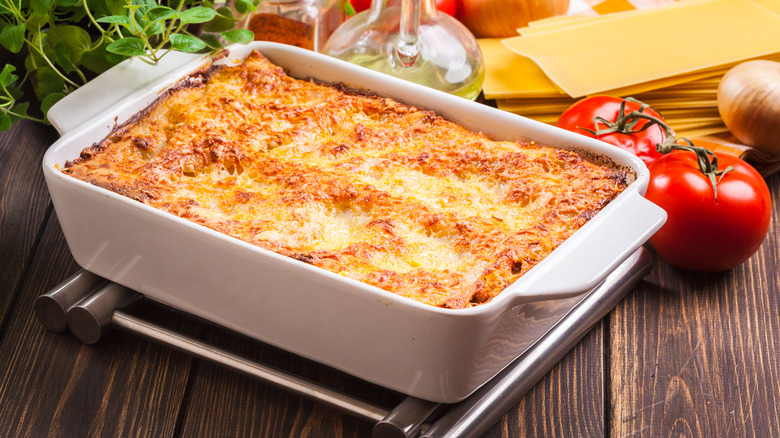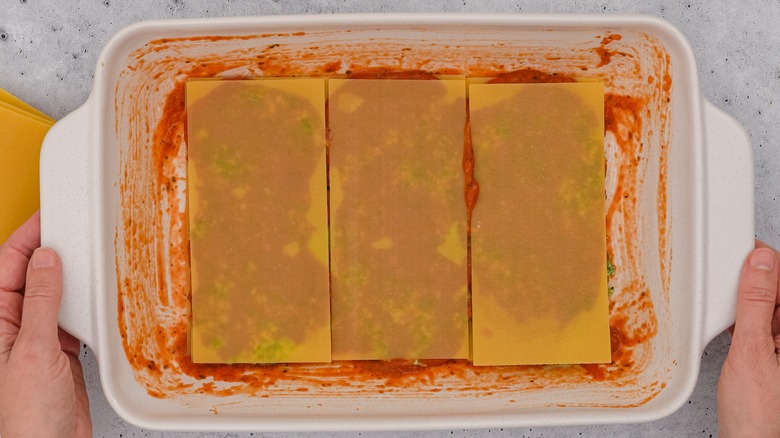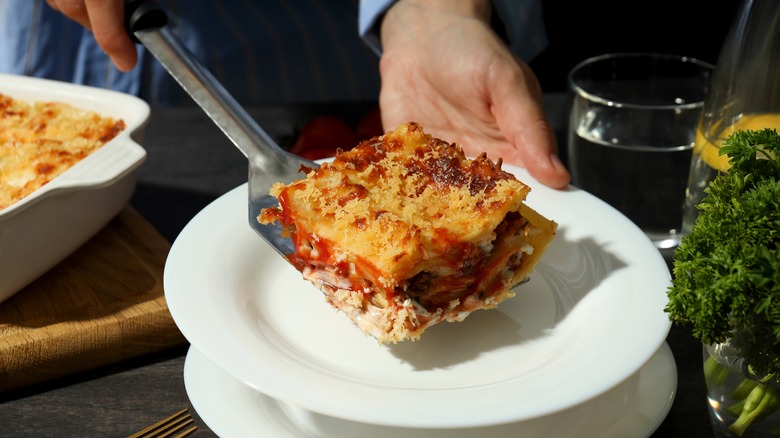Lasagna Cooking Tips And Tricks You'll Wish You Knew Sooner
You could say that lasagna is a baked pasta dish, but this description wouldn't do justice to this hearty casserole. Lasagna is the ultimate comforting classic in which tender pasta gets slathered in potently flavored meat sauce, usually followed by the velvety smooth béchamel or partnered with zingy ricotta. Add in the cheese and an oven that will yield the crispy crust, and you have the perfect dish. Besides this beautiful harmony of textures and flavors, lasagna is a stunner and immediately draws you with its impressive looks.
Lasagna has started its journey in Italy, where you will still find many regional variations, but it has come a long way from its origins. These days, it graces the menus of most Italian restaurants around the globe, and though it has built its reputation as a true restaurant classic, it still embodies the ultimate home-cooked meal that is best-served family style. Luckily, lasagna is not an overly complicated dish to make. However, to pull out a stellar version, you will need some practical tips and tricks to guide you through the process, and steer you in the right direction. Read the list and be prepared for the next lasagna night.
Build your sauce with right ingredients
The heart of every lasagna is the flavor-packed red sauce. The traditional version is typically made with thick Bolognese, a sauce brimming with a meaty flavor, herbal aromatics, and plenty of underlying sweetness. This sauce makes the backbone of every lasagna that is simply complemented by tender pasta and usually some type of white sauce. As a central part of the dish, it calls for maximum attention and the best ingredients.
Bolognese sauce starts with the meat, and the best option is to combine ground beef and pork. Beef provides sturdiness, while pork brings in a milder profile. Always opt for cuts with some fatty parts. Lean ground meat can't perform well in this sauce. The meaty base also needs vegetables — this is best built with a classic mix of finely diced carrots, onions, and celery — that will provide a lighter background note. Always use canned tomatoes. San Marzano tomatoes are usually the safest option as the quality is unparalleled, though you can use other varieties. However, you should never squish in fresh tomatoes as they might water it down and bring too much acidity. Though meat should deliver some fattiness, you still need something to round out the whole thing. Either opt for butter or olive oil, but rendering some pancetta is also an excellent option to create more depth. You can even experiment with sausages or smoky prosciutto. Whichever combination you choose, make sure always to use top-quality ingredients.
Don't speed up the process
Lasagna sauce calls for the right ingredients and a lot of time. Generally, there are no shortcuts or speeding up when it comes to lasagna, and this rule starts with the sauce. If you opt for the classic Bolognese, you need to set aside plenty of time to get lip-smacking results.
In traditional Italian cuisine, meat ragùs and the Bolognese sauce, as the classic representative, take hours to cook. Forget about half-an-hour recipes and quick fixes with canned sauces. There are no secrets or complicated techniques; when the sauce is assembled, the trick is to leave it on the stove for a couple of hours, keeping heat at a minimum. Using high-quality ingredients and the time-consuming cooking process will amplify flavor, creating an incredibly complex sauce. A long simmer also creates a homogenous texture where all elements come together to create perfect unity. Italy is well-known for its meat sauces, and though they differ in the choice of ingredients, you will find that the universal tip is always to cook it low and slow.
If you are building a meatless, marinara-like sauce, you probably don't need to cook it as long as you would the meat ragù. However, you still want to give the sauce enough time on the stove to reduce, attain the right texture, and concentrate all the flavors.
Add a splash of milk to the meat sauce
Italian cuisine is one of the most popular national cuisines in the world. Because of this, you'll sometimes see some classic dishes turned into culinary abominations that have nothing to do with tradition. Though adding milk to a meat sauce might sound like one of those questionable international atrocities, you'll be surprised to discover that milk is an essential addition to a classic Bolognese.
Adding milk is the secret trick that will take your lasagna sauce to the next level. Milk is rich in fat and can quickly neutralize flavors. In this sauce, milk helps tone down the acidity built with wine and tomatoes. It also lends some of its milky richness, amplifying the creaminess and essentially changing the texture. Milk should be added towards the end when you're about to take the sauce off the stove. If you add it too soon, the acidity might still be too potent and curdle the milk, leading to a broken sauce. Make sure to thoroughly blend in the milk, and watch your sauce instantly transform.
Use wine you'd want to drink
Besides being a great pairing partner, wine can also be a fantastic cooking ingredient. A splash of wine in a hearty stew is a classic — think of the legendary beef bourguignon — but it is also used to create amazingly potent wine sauces and give an edgy note to various other dishes. In lasagna, wine is the transformative element added to the meat sauce. It boosts the acidity, and all those complex flavors get integrated into the sauce. Though you'll sometimes see chefs adding red wine, probably because it seems like a logical choice for a beefy sauce, the traditional choice is white wine. Whether you follow tradition or not, there is only one tip that you should pick up, which suggests you should never use wine you wouldn't want to drink.
Wine is packed full of aromas and flavors, which will end up in your sauce, so you want to use the good stuff. If there are faults, astringency, and unpleasant or harsh notes in the wine, they will give the sauce the same characteristics. Of course, you don't have to crack the most expensive Bordeaux blend. The wine will cook in the sauce, so reserve the finest labels for sipping and savoring.
Cheese matters
Cheese appears in lasagna in many different forms. Italians often blend it with the creamy béchamel sauce and sprinkle grated cheese on top of the casserole. In southern Italy, they use ricotta instead of béchamel, a tradition that was warmly adopted in the U.S. You'll also often see mozzarella listed as an ingredient. While Italians use fresh mozzarella, the American version is stringier and has much more in common with scamorza cheese. Essentially, lasagna can work with many cheese varieties, but the only tip you should follow is to use good cheese. Don't expect a low-grade cheese such as highly processed Velveeta to do the trick. You want cheese that has good melting properties and, most of all, good flavor.
Besides these classics, there are many unique cheeses you can use in lasagna. Good-quality cheddar is always a reliable option. Cream cheese and mascarpone will boost creaminess, but be aware of the fat content, so use them scarcely or instead of white sauce. If you want to make your lasagna stand out, play with blue or goat cheese, which will give it a whole new profile. Cheeses such as provolone and pepper jack are always a good idea.
Remember to use cheese whose flavor you like, and the one that will complement all other ingredients. Also, consider the texture and saltiness it will deliver to the dish. If you're using grated cheese, make sure to grate it fresh.
Nutmeg and béchamel are the perfect match
Béchamel is a dense, French-style sauce standardly used in Italian lasagna, typically ladled in a thin layer over the ragù. The sauce has a creamy, almost velvety texture, giving the dish an utterly creamy mouthfeel. Béchamel is not regularly used in international lasagna renditions, but we're here to remind you that it is the secret trick that will yield the creamiest lasagna. Another tip is to spice it with fresh nutmeg, as the two make perfect partners.
Béchamel is cooked on the stove and comes together in no time. It starts as a classic roux with flour toasted in butter, while milk is slowly added to create a sauce-like texture. Salt and pepper are classic seasonings, but a whiff of nutmeg is a much-desired addition. This small but mighty spice will give béchamel a much sturdier flavor and a deeper aromatic profile that will partner nicely with the hearty meat ragù. As it holds its shape well, béchamel will stay in place when you cut it into the lasagna, so you'll get a nice, clean slice that won't break when plated. It is also easy to work with and distribute in an even layer.
If you're not ready to give up on your tangy ricotta lasagna, blend some ricotta with the béchamel, and you'll get creaminess and a subtle ricotta kick. Remember that you can always mix some grated cheese for extra cheesiness.
Go heavy on the seasoning
Lasagna is a versatile dish, ideal for playing with various ingredients and additions. It can take on many different flavors, and it seems nothing is too much for lasagna. But the only time it can't perform well is if it's underseasoned. Essentially, if you start building with bland elements, you will end up with a poor-tasting dish. So, the best advice here is not to be afraid to heavily season every layer of your casserole as it is the only way to attain the perfect flavor structure.
You want to get to the point where each element that is supposed to go to lasagna is so well-seasoned that you can consume it independently. If you have a classic ragù, make all those sweet and savory notes stand out. Add enough salt and pepper to balance out the tomato sweetness for a marinara sauce, and don't forget the herbal note that blends so well into the mix. If you are using béchamel, season the base with salt and pepper, but add enough nutmeg so it can break through all those layers. For a ricotta mix, there are no limits. Besides the classic options, ricotta will greatly contribute from a whiff of lemon juice or zest, but most fresh herbs will also make a fantastic addition. Remember that lasagna is built with thin layers and neutral pasta sheets, so make sure all those spices stand out with every bite.
Use fresh lasagna sheets to build more layers and speed up the cooking process
Apart from Italy, where pasta is still frequently made from scratch, fresh pasta is not something you'll usually see made by home cooks. Luckily, for most of us, pasta dries well and has a relatively long shelf life, so it's pretty easy to have it on hand. Though dry pasta does a great job and has some advantages, for lasagna, fresh sheets are a complete game changer that will instantly upgrade your recipe.
Fresh pasta is more tender to start with and will become softer after cooking. It also works better at soaking up all those delicious juices from béchamel and the meat sauce. Because it does not have to cook, you can use more layers than you would with dry pasta. It also significantly reduces cooking time, preventing those burnt edges and undercooked centers.
If you can't buy fresh lasagna sheets, it is relatively easy to make them from scratch. The dough assembles quickly and uses only flour, eggs, and salt. There is no need for intricate designs; you just have to roll the dough thinly — or use a pasta machine if you have one — and they are ready to go inside the lasagna. An added plus is that you can cut the sheets to fit perfectly into your baking dish.
If you're working with dry noodles, oil them after cooking
Fresh lasagna sheets might be the ideal choice for building the perfect, fork-tender lasagna, but in reality, most home cooks will turn to the more convenient dry pasta sheets. You'll find these sheets at most supermarkets. They are sold in boxes and mainly take the shape of a small rectangle that usually perfectly fits in a standard casserole dish. Some of these noodles are labeled as no boil, and those can go straight to the lasagna, where they will tenderize by soaking up the liquid from the sauces.
Besides these, you'll find old-school noodles that require a short toss in boiling water. If you are working with the latter, the tip you should always follow is to oil your noodles after they are cooked. This will help with the starch, and the noodles won't stick or clump into one giant pasta ball. You can also layer the sheets for easier use. When you boil these noodles, generously salt the water. Like any pasta, lasagna sheets love and greatly benefit from seasoning, and this is a great chance to impart more flavor.
Be generous with sauce, but don't overdo it
Sauces are an integral part of the lasagna. They pack the most flavor and give the dish a distinctive gooey texture, but this does not mean that lasagna should be a saucy dish. When you slice into a well-built lasagna, you should get a firm, stable chunk where all layers are visible. Though we like to promote the more-is-better philosophy when it comes to sauces, this rule does not apply to lasagna. If you use too much sauce, it will lead to a soupy and watery lasagna that cannot hold shape on the plate.
Regardless of which or how many sauces you prefer to use, you want everything distributed evenly on each layer. Make sure that the sauce covers every nook and cranny, but don't be too zealous and dump too much in one go as tender pasta will not be able to carry such a load. If you have too much sauce, add an extra pasta layer to provide more support and keep the thing in place. Pay special attention to the top layer. You need to be extra careful to put enough sauce to cover every part of the pasta. If you leave anything out, it will dry out and become unpleasantly brittle.
Use the right baking dish
If you think any ovenproof dish is suitable for lasagna, we're here to let you in on a little secret. Some materials perform better for rich and saucy dishes, such as lasagna. The best choice for a thick, layered casserole are the pans where the heat is distributed evenly and those who stay warm long after they leave the oven. Enameled cast iron and stoneware are the most reliable options to provide an evenly cooked lasagna and keep the pie warm for the second serving. Glass is a good alternative if you have one on hand. You also want to opt for dishes with handles for easier handling.
Besides the material, make sure you use the correct size. Ideally, you want to work with the standard 9 x 13-inch casserole dishes. These usually have taller edges, so you have enough room to stack many layers and prevent the dreadful overflow. With wider pans, your lasagna will not be able to attain enough height and stunning thickness. This pan is also a standard measure for lasagna sheets, so they'll fit in perfectly.
Always spread some sauce on the bottom of the dish
When you are all set and ready to assemble the lasagna, remember that sauce goes first. People usually assume that lasagna needs a firm base, so they start layering it by putting the pasta first. This usually ends up with thick, brittle, and burnt pasta. The trick is always to spoon some sauce on the bottom of the baking dish. This will not make your lasagna soggy or moist, as the pasta will soak it up, and you will be rewarded with a tender but firm bottom layer.
The sauce also ensures that your pie does not stick to the bottom, so there is no need to butter or oil the dish. Usually, you will use red sauce for this purpose as it is more runny than any white sauce. You don't have to use a lot — a couple of spoonfuls will be enough — but make sure you spread it across the bottom and don't skip the corners.
Let your lasagna rest before you dig in
The last tip you should follow to get the picture-perfect lasagna slice is to let your heavy casserole dish rest before you slice into it. This is generally recommended with dishes as massive as lasagna that are built with multiple layers packed with gooey elements. When you take the lasagna out of the oven, it will continue to bubble and cook. If you slice into it before it's set, the sauces will ooze out like lava, leaving a messy, soup-like puddle on the plate. Setting it aside, even for 10 minutes, will give the heat enough time to distribute and all the liquid to be reabsorbed by the sauce and the noodles.
You should also resist the urge to dig in with your dull spatula. If you achieve that perfectly crusty top of your lasagna, you'll need something sharper. Use a serrated knife or a sharp chef's knife to slice a perfect square before you spoon it out with a spatula. These simple tips will reward you with that perfect-looking slice and prevent you from scorching your tongue.
